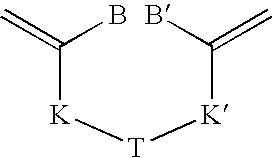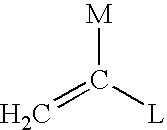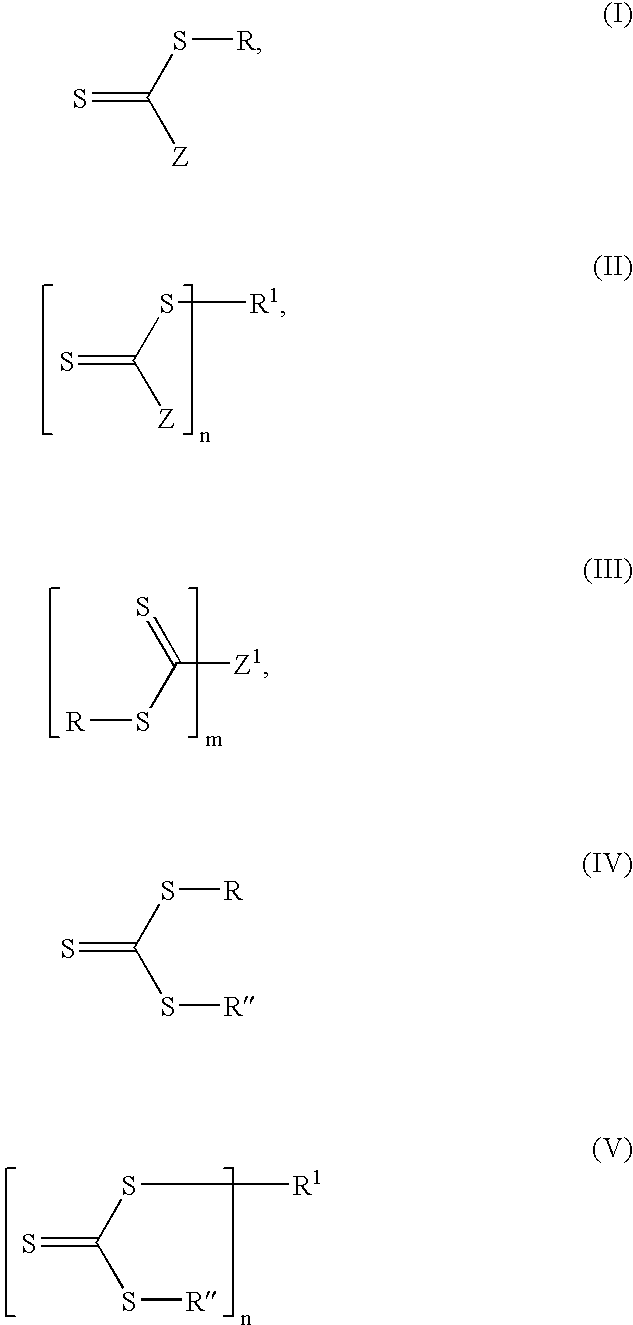Process for synthesizing thiol terminated polymers
a technology of thiol and polymer, which is applied in the field of polymer thiol synthesis, can solve the problems of disadvantage, color and odor of polymers, and interfere with subsequent processing steps or the intended application,
- Summary
- Abstract
- Description
- Claims
- Application Information
AI Technical Summary
Benefits of technology
Problems solved by technology
Method used
Image
Examples
example 1
[0096] 2-Phenylethyl dithiobenzoate (14.9 mg) (quartet at 5.2 ppm in proton NMR for S—C—H) and 2-(dimethylamino)ethylamine (8 μL, 20% molar excess) (triplets at 2.8 and 2.4 ppm in proton NMR) were added to CDCl3 (0.7 mL) which was flushed with nitrogen. An immediate color change from orange to yellow was observed. NMR analysis showed essentially complete reaction after 1 hour to give N-(2-(dimethylamino)ethyl)benzothioamide (triplets at 3.9 ppm and 2.7 ppm for CH2—CH2)and 1-phenylethanethiol (multiplet at 4.2 ppm for S—C—H).
example 2
[0097] S-cyanomethyl S′-dodecyl trithiocarbonate (15.1 mg) (triplet at 3.4 ppm for R—CH2—S and singlet at 4.1 ppm for S—CH2—CN in proton NMR) and 2-(dimethylamino)ethylamine (4.6 mg, 20% molar excess) were added to CDCl3 (0.7 mL) which was flushed with nitrogen. An immediate color change from yellow to almost colorless was observed. NMR analysis showed the reaction was complete after 24 hours. The products were identified by NMR as dodecyl 2-(dimethylamino)ethylcarbamodithioate (triplets at 3.7, 3.2 and 2.5 ppm for the three CH2's) and mercaptoacetonitrile (singlet at 3.25 ppm for S—CH2—CN)
[0098] The following examples demonstrate the cleavage of thiocarbonylthio end groups of polymers to form thiol end groups.
example 3
[0099] Preparation of S-poly(methyl methacrylate) S′-dodecyl trithiocarbonate (Mn 3400) [(CH3)2C(CN)—PMMA-SC(═S)SC12H25]. A solution of the RAFT agent C12H25SC(S)SC(CN)(CH3)2 (685 mg) and VAZ®88 (10.5 mg) in methyl methacrylate (7.0 mL) and benzene (3.0 mL) was degassed and heated at 90° C. for 6 hours. Removal of the volatiles under reduced pressure afforded a yellow polymer (5.3 g, 81% conversion) of Mn=3400 and Mw / Mn=1.18. The end-group protons on carbon next to sulfur [—SC(S)SCH2C11H23] appeared at 3.2 ppm in the proton NMR.
[0100] The above polymer (34 mg) in CDCl3 (0.6 mL) and 2-(dimethylamino)ethylamine (1.3 mg, 50% molar excess) in CDCl3 (0.1 mL) transferred to nitrogen flushed NMR tube. A marked color reduction was observed. NMR analysis showed the end group was cleaved by the formation of dodecyl 2-(dimethylamino)ethylcarbamodithioate (see Example 2)
PUM
| Property | Measurement | Unit |
|---|---|---|
| Composition | aaaaa | aaaaa |
| Color | aaaaa | aaaaa |
| Surface properties | aaaaa | aaaaa |
Abstract
Description
Claims
Application Information
 Login to View More
Login to View More - R&D
- Intellectual Property
- Life Sciences
- Materials
- Tech Scout
- Unparalleled Data Quality
- Higher Quality Content
- 60% Fewer Hallucinations
Browse by: Latest US Patents, China's latest patents, Technical Efficacy Thesaurus, Application Domain, Technology Topic, Popular Technical Reports.
© 2025 PatSnap. All rights reserved.Legal|Privacy policy|Modern Slavery Act Transparency Statement|Sitemap|About US| Contact US: help@patsnap.com



